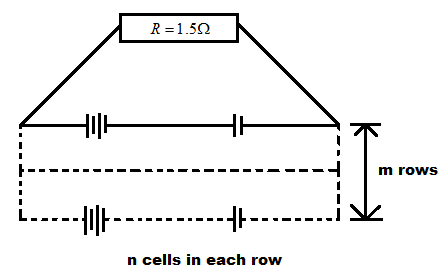
12 cells, each of emf $1.5{\text{V}}$ and internal resistance $0.5\Omega $.are arranged in ${\text{m}}$ rows each containing $'{\text{n'}}$ cells connected in series, as shown. Calculate the values of $'{\text{n'}}$ and ${\text{'m'}}$ for which this combination would send maximum current through an external resistance of $1.5\Omega $.

Answer
173.1k+ views
Hint: In this question, we are having $12$ cells and each cell is having $15{\text{V}}$emf. There are ${\text{m}}$ number of rows and each row is having ${\text{n}}$ cells in each row that are connected in the series. The load resistance is equal to $1.5\Omega $. First, we find the ${R_{{\text{internal}}}}$ by using the resistance in series and parallel formulas and putting it into load resistance and find the value of ${\text{n}}$ and ${\text{m}}$.
Formula used:
Resistance in the series is written as;
${R_s} = {R_1} + {R_2} + .......$
Resistance in parallel is written as;
$\dfrac{1}{{{R_p}}} = \dfrac{1}{{{R_1}}} + \dfrac{1}{{{R_2}}} + ......$
Complete step by step solution:
Here we can write the load resistance as;
${R_{{\text{load}}}} = {R_{{\text{internal}}}} - - - - (1)$
Now here we are having ${\text{n}}$ number of resistances in series so we can write it as,
${R_s} = nr$
Here we take $r$ for resistance in series because we are not getting any confusion.
And we have ${\text{m}}$ a number of resistance parallel formation.
Therefore, we can write internal resistance as,
${R_{{\text{internal}}}} = \dfrac{{{\text{n}}r}}{{\text{m}}}$
Now put this value in the equation $(1)$ we get;
${R_{{\text{load}}}} = \dfrac{{{\text{n}}r}}{{\text{m}}} - - - - (2)$
Here we have, $r = 0.5\Omega ,{R_{{\text{load}}}} = 1.5\Omega $, putting these values in the equation $(2)$ we get;
$1.5 = \dfrac{{\text{n}}}{{\text{m}}} \times 0.5 \\
\Rightarrow \dfrac{{\text{n}}}{{\text{m}}} = \dfrac{{1.5}}{{0.5}} \\
\Rightarrow \dfrac{{\text{n}}}{{\text{m}}} = 3 - - - - (3) \\
$
Now, we have total cells is,
$
{\text{n}} \times {\text{m = }}12 \\
\Rightarrow {\text{nm = }}12 - - - (4) \\
$
Dividing equation $(3)$ by the equation $(4)$ we get;
$
\dfrac{{\text{n}}}{{{\text{n}}{{\text{m}}^2}}} = \dfrac{3}{{12}} \\
\Rightarrow \dfrac{1}{{{{\text{m}}^2}}} = \dfrac{1}{4} \\
\Rightarrow {{\text{m}}^2} = 4 \\
\Rightarrow {\text{m = 2}} \\
$
Now, put this value of ${\text{m}}$ in the equation $(4)$ we get;
$
{\text{nm = 12}} \\
\Rightarrow {\text{n = }}\dfrac{{12}}{2} \\
\Rightarrow {\text{n = 6}} $
Hence there are $6$ cells in series and $2$ cells are parallel.
Hence, the value of ${\text{n = 6}}$ and ${\text{m = 2}}$.
Note: Do not confuse the formulas of series and parallel formation of resistance, they both have different formulas. If the resistances are connected in series then the overall resistance of the combination equals the sum of the resistance of each resistor and in case of parallel condition the overall resistance is less than the resistance of each resistor.
Formula used:
Resistance in the series is written as;
${R_s} = {R_1} + {R_2} + .......$
Resistance in parallel is written as;
$\dfrac{1}{{{R_p}}} = \dfrac{1}{{{R_1}}} + \dfrac{1}{{{R_2}}} + ......$
Complete step by step solution:
Here we can write the load resistance as;
${R_{{\text{load}}}} = {R_{{\text{internal}}}} - - - - (1)$
Now here we are having ${\text{n}}$ number of resistances in series so we can write it as,
${R_s} = nr$
Here we take $r$ for resistance in series because we are not getting any confusion.
And we have ${\text{m}}$ a number of resistance parallel formation.
Therefore, we can write internal resistance as,
${R_{{\text{internal}}}} = \dfrac{{{\text{n}}r}}{{\text{m}}}$
Now put this value in the equation $(1)$ we get;
${R_{{\text{load}}}} = \dfrac{{{\text{n}}r}}{{\text{m}}} - - - - (2)$
Here we have, $r = 0.5\Omega ,{R_{{\text{load}}}} = 1.5\Omega $, putting these values in the equation $(2)$ we get;
$1.5 = \dfrac{{\text{n}}}{{\text{m}}} \times 0.5 \\
\Rightarrow \dfrac{{\text{n}}}{{\text{m}}} = \dfrac{{1.5}}{{0.5}} \\
\Rightarrow \dfrac{{\text{n}}}{{\text{m}}} = 3 - - - - (3) \\
$
Now, we have total cells is,
$
{\text{n}} \times {\text{m = }}12 \\
\Rightarrow {\text{nm = }}12 - - - (4) \\
$
Dividing equation $(3)$ by the equation $(4)$ we get;
$
\dfrac{{\text{n}}}{{{\text{n}}{{\text{m}}^2}}} = \dfrac{3}{{12}} \\
\Rightarrow \dfrac{1}{{{{\text{m}}^2}}} = \dfrac{1}{4} \\
\Rightarrow {{\text{m}}^2} = 4 \\
\Rightarrow {\text{m = 2}} \\
$
Now, put this value of ${\text{m}}$ in the equation $(4)$ we get;
$
{\text{nm = 12}} \\
\Rightarrow {\text{n = }}\dfrac{{12}}{2} \\
\Rightarrow {\text{n = 6}} $
Hence there are $6$ cells in series and $2$ cells are parallel.
Hence, the value of ${\text{n = 6}}$ and ${\text{m = 2}}$.
Note: Do not confuse the formulas of series and parallel formation of resistance, they both have different formulas. If the resistances are connected in series then the overall resistance of the combination equals the sum of the resistance of each resistor and in case of parallel condition the overall resistance is less than the resistance of each resistor.
Recently Updated Pages
JEE Main Mock Test 2025-26: Chapter-Wise Practice Papers

JEE Main Electromagnetic Waves Mock Test 2025-26 | Free Practice Online

JEE Main 2025-26 Electronic Devices Mock Test: Free Practice Online

JEE Main Mock Test 2025-26: Current Electricity Practice Online

JEE Main 2025-26 Electrostatics Mock Test – Free Practice Online

JEE Main 2025-26 Units and Measurements Mock Test Online

Trending doubts
JEE Main 2025 Session 2: Application Form (Out), Exam Dates (Released), Eligibility, & More

Displacement-Time Graph and Velocity-Time Graph for JEE

Uniform Acceleration

Electric field due to uniformly charged sphere class 12 physics JEE_Main

JEE Main 2025: Derivation of Equation of Trajectory in Physics

Learn About Angle Of Deviation In Prism: JEE Main Physics 2025

Other Pages
JEE Advanced Marks vs Ranks 2025: Understanding Category-wise Qualifying Marks and Previous Year Cut-offs

Instantaneous Velocity - Formula based Examples for JEE

JEE Advanced Weightage 2025 Chapter-Wise for Physics, Maths and Chemistry

Essential Derivations for CBSE Class 12 Physics: Stepwise & PDF Solutions

Electron Gain Enthalpy and Electron Affinity for JEE

Wheatstone Bridge for JEE Main Physics 2025




